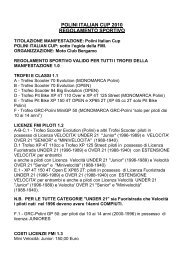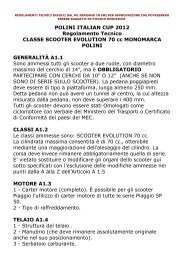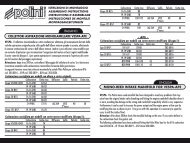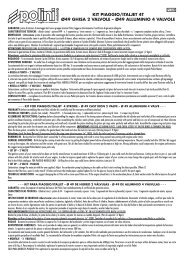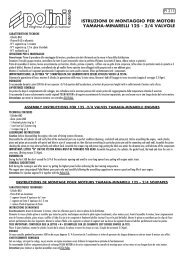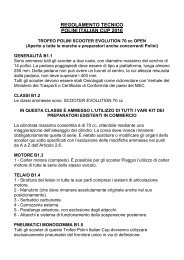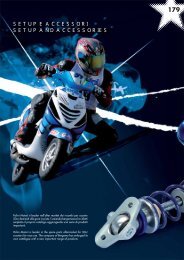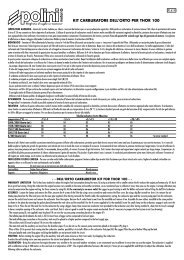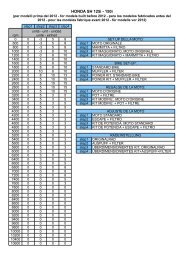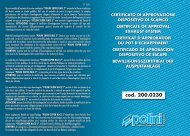THOR 100 - 200 - Polini
THOR 100 - 200 - Polini
THOR 100 - 200 - Polini
You also want an ePaper? Increase the reach of your titles
YUMPU automatically turns print PDFs into web optimized ePapers that Google loves.
- Engine improper use or misusage;- Assembly of parts or components not specified for the engineuse;- Engine overheating or stop after long usage, beyond the termindicated by <strong>Polini</strong>;- Missing or irregular engine servicing as suggested by <strong>Polini</strong>, useof improper petrol or oils, presence of dirty parts or foreignbodies in the engine, even sucked;- Engine overwork because overloaded;- Engine or parts deterioration because of improperly storage;- Faulty engine assembly, including the use of not original <strong>Polini</strong>parts or coming from third parties;- Damages to the engine caused by foreign bodies;- Servicing operated by person outside <strong>Polini</strong> or by not authorized people;- Competition use of the engine.Final user obligationsClaims shall be done by delivering the engine to a <strong>Polini</strong> authorizeddealer. The user shall provide the original document that provesthe purchasing or the warranty ticket authenticated by <strong>Polini</strong>or by its distributor. To keep the validity of the warranty the usershall carry out recurrent servicing according to the use and maintenancemanual.Limited liabilityPursuant to this warranty, <strong>Polini</strong>’s obligations are limited to thedefective parts reparation or, at its discretion, to change one ormore parts, necessary to remedy every malfunctioning caused bydefective materials or labor covered by the warranty. <strong>Polini</strong> orthe distributor can’t be held responsible for problems or damagesto persons/things/animals during the engine life. We remindyou that this product is not certificated and it is onlydedicated to experimental aircraft and that it can break orsuddenly stop working. No warranty or compensation are foreseenfor damages caused to:- persons/animals/things during the engine use- persons/animals/things caused by a collide with the propelleror with parts detached from the engine- frame, parts and/or propeller caused by the collide with partscoming out from the engine- costs for rescue, shipping, phone or rent after the collide,problems or loss of time, or other indirect damages.DANGER! This not-certified engine can suddenly stop working.The engine stop can require emergency landings causinginjuries or death. The aircraft thrusts by this engine should fly inopen spaces only or during the daylight. The buyer assumes allthe risks for the use and he knows that by using it the engine cansuddenly stop working. This product is not covered by productsand public liability. Who flies with a paramotor or onlyswitches it on assumes all the risks inherent to theparagliding sport and all the responsibilities for damagesto things or persons or death caused by the use ofthis product.2- FUELThor <strong>100</strong>/<strong>200</strong> is a 2-stroke engine that needs oil/petrol mixture.Only use good lead-free petrol purchased by a petrol station with98 octane. Add good 2% synthetic oil to the petrol. It is possibleto use a 1,5% oil mixture with the following oils:MOTUL 800 - CASTROL 242 - BARDAL KXT - ELF 976 - ELF 909.WARNING: The nature of the carbon deposits on the cylinderhead, spark plug and exhaust port give important informationabout the fuel mixture burning in your engine. Remember thatmixes that contain too much oil do not extend the engine’s life.ATTENTION: petrol is extremely inflammable and explosive.Carry out these operations in a well ventilate place and withthe engine switched off. Refrain from smoking and avoid allnaked flames or sparks where petrol is being drained or wherere-fuelling is being performed.3- ENGINE STARTINGStart the engine only when all is in good conditions and perfectlyworking. Furthermore check that all the nuts are well tightened.3.1 WALBRO CARBURATOR (<strong>THOR</strong> <strong>100</strong>-<strong>200</strong>)First cold starting: fill in the fuel system using the pump provided(carefully follow the instructions provided by the frame’s manufacturerto find out it and use it in the correct way). To make thisoperation easier push softly with a finger the diaphragm throughthe hole indicated by the arrow in photo 1. Fill it in till the petrolreaches the carburettor. At that moment immediately stop; if yougo on acting on the pump the petrol will leak causing the engineflooding.01WALBRO WG8 CARBURETOR (<strong>THOR</strong> <strong>100</strong> engine only):Move the starter level to the off position (photo 1); now hand thestarter and start pulling the rope till it grows hard. Pull withstrength without accelerating till the engine seems to start working(do not repeat this operation more than 3 times otherwisethe engine may flood). Now move the starter lever to the onposition (photo 2) and act on the starting rope without accelerating.If the engine doesn’t work with the first two attempts, tryagain accelerating gently.023.2 24/28 PWK CARBURETORFill in the fuel system till the petrol reaches the carburetor holeand then pump up three times (using the pump provided- Code316.0016) to fill out the bowl. To start the engine pull upwardsthe black level placed in the upper side of the carburettor.Work the starter without accelerating till the engine start. Once itworks switch it off, disconnect the starter and start the engineagain slightly accelerating. For your safety only start the engineafter your harness has been COMPLETELY fixed!3.3 <strong>THOR</strong> <strong>200</strong> ENGINE STARTING WITH ELECTRICSTARTERAccording to the carburettor model (Pwk or Walbro WB37) referto section 3.1 and 3.2 to fill in the fuel system. For the modelwith electric starter the <strong>Polini</strong> throttle system has 3 buttons on thebottom part of the throttle device. To start both the engines pushthe black buttons together and slightly accelerate. For your safetyonly proceed with this operation after your harness has beenCOMPLETELY fixed!ATTENTION: keep the switch in your hand during all the stagesand be ready to work it in case of any anomaly. If necessarykeep it pressed till the engine has completely stopped.Once the engine starts we suggest testing the right functioning ofthe kill switch button. After having checked it, start the engineagain without accelerating and without using the starter. Nowstart the engine and leave it idle until it warms up to normaltemperature.4- RUNNING INRun your engine in as instructed below to ensure that the engineand transmission bed in correctly and to ensure continuous reliabilityin future. Once the engine starts, leave it idle until it warmsup to normal temperature. We suggest running the engine 15minutes at medium-low engine power output gently acceleratingand with different intensity. Now we suggest checking the correctidling calibration.During the first flights or for the first 20 litres of petrol we suggestnot keeping the engine at the maximum rpm for too muchtime, considering that the 2-stroke engine doesn’t stand to theconstant rpm even if of medium power. We suggest varying theengine rpm. Check the carburetion after the first landing (section6). Repeat the running in every time you change one of the followingparts: piston, rings, cylinder, crankshaft or main bearings.5- ENGINE SWITCING OFFSwitch the engine off by pressing the button till the complete stop(see the frame manufacturer’s instructions to find the buttonposition)6- CARBURETION CHECKFor a complete carburetion check switch the engine off afterhaving worked it for some minutes under load. Remove thespark plug; unscrew it by using the proper key and verify thatthe porcelain colour is light-brown. On the contrary, ask to anauthorized dealer for the calibration.7- CLEANINGClean the engine when it is switched off and cold to avoid burns.Clean the engine with a soft cloth soaked with neutral cleansingand non-aggressive.WARNING: Do not use acids that may damage the engine.8-CARRIAGEATTENTION: Carry the engine only when cold. Follow theframe manufacturer’s instructions for its carriage. Be careful ofthe petrol during the carriage; its leaking may cause a fire.8.1 CARRIAGE OF THE ENGINE WITH PWKCARBURETORPWK carburetor has a breather pipe studied to carry the enginewhen lying. To empty the carburettor unscrew half turn the breatherbrass nut (highlighted in photo 3 with an arrow) and wait tillthe fuel enters the tank. Close the brass connection again. Nowthe carburettor is empty and you can lay the engine ready to becarry.ATTENTION: never unscrew more than half a turn the breathernut to avoid damaging the OR seal. Never close too hard.



